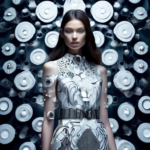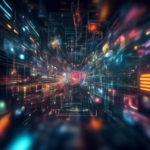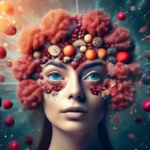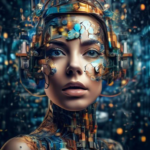In the dawn of the digital age, as pixels transform into breathtaking works of art, a wave of innovation is sweeping through our visual landscape. AI-generated images, once confined to the realm of science fiction, are now bursting forth as vivid testimonies to the power of artificial intelligence. These digital marvels are not only redefining how we create and consume visual content but are also reshaping industries ranging from advertising to fashion, from entertainment to education.
Imagine a world where artistic vision is no longer limited by human hands or imagination. Instead, sophisticated algorithms conjure up visuals that challenge our very notion of creativity. This isn’t just the future — it’s happening now. As we delve into the emergence of AI-generated imagery, we’ll explore the astounding ways in which this technology is disrupting traditional practices, democratizing creativity, and opening doors to a new realm of possibilities. Ready to dive into the future of visual artistry? Let’s explore how AI-generated images are not just a trend, but a transformative force in the industry.
Table of Contents
- The Artistic Evolution: AI Takes the Creative Reins
- Redefining Realism: How Pixels Are Becoming Perfect
- Behind the Algorithm: Decoding AIs Creative Process
- Breaking Boundaries: AI in Advertising and Media
- Challenges on the Canvas: Ethical Implications and Solutions
- Empowering Creatives: How to Leverage AI Tools Wisely
- Navigating Copyright: Protecting Your Originality
- A Collaborative Future: Harmonizing Human and Machine Creativity
- Final Thoughts
The Artistic Evolution: AI Takes the Creative Reins
The digital renaissance is here, and the maestro orchestrating this symphony is artificial intelligence. The capability of AI to generate images that blur the lines between reality and imagination has not only opened new avenues for creatives but also transformed how industries approach art. From concept art for video games to fashion design, the infusion of AI-generated images is setting new benchmarks.
- Speed: Gone are the days when producing a high-quality image was a laborious task. AI can generate intricate designs in mere seconds, allowing artists to iterate rapidly and refine their concepts.
- Cost Efficiency: Hiring a professional artist or photographer can be expensive. AI democratizes the creative process, making it accessible to enthusiasts and startups with limited budgets.
- Endless Creativity: AI can pull from a vast database of styles, techniques, and cultural influences, creating unique and unexpected amalgamations that inspire new artistic directions.
| Traditional Art | AI-Generated Art |
|---|---|
| Time-consuming | Instantaneous |
| Costly | Cost-effective |
| Skill-dependent | Accessible |
Artists and designers have warmly embraced these innovations, using AI as a collaborator rather than an adversary. For instance, digital artist Refik Anadol uses data-driven machine learning algorithms to create mesmerizing, swirling patterns that evoke a sense of living energy. Fashion designers are leveraging AI to conjure futuristic aesthetics that challenge traditional norms of beauty and functionality.
To truly appreciate the innovation, consider the example of AI in comic book creation. Writers can input basic story elements, and AI generates entire visual scenes, adding a level of dynamism that breathes life into narratives. This collaboration broadens the horizons of storytelling, making it more interactive and visually engaging.
Redefining Realism: How Pixels Are Becoming Perfect
In the rapidly evolving landscape of digital artistry, the rise of AI-generated images is nothing short of revolutionary. Thanks to advancements in machine learning, neural networks, and deep learning algorithms, we’re witnessing a transformation where pixels are no longer mere elements of a digital canvas—they’re becoming reflections of stunning reality. This technological evolution is not only bridging the gap between imagination and visualization, but it’s also fundamentally challenging traditional methods of image creation.
One of the most captivating aspects of AI-generated images is their unparalleled **precision and detail**. With algorithms capable of learning from vast datasets, these systems can generate images that are **indistinguishable from real photos**. Consider the following enhancements AI brings to image creation:
- High-Resolution Detail: AI can enhance images to ultra-high definition, showcasing fine details that were previously unimaginable.
- Dynamic Color Adjustments: Automatic colorization and correction techniques yield perfectly balanced and vibrant images.
- Seamless Texture Integration: AI can analyze textures and apply them realistically across different elements within an image.
Creative professionals are no longer constrained by the limitations of traditional tools. AI is democratizing content creation, making it accessible to a broader range of individuals. Interactive platforms powered by AI allow users to generate high-quality graphics with minimal effort, empowering everyone from amateur artists to seasoned designers. The process has become as intuitive as selecting a few parameters and letting the AI work its magic.
The economic implications are striking as well. The **cost-efficiency** of AI-generated images is transforming industries. Here’s a quick overview:
| Industry | Impacts & Benefits |
| Advertising | Reduced production costs and faster turnaround times. |
| Entertainment | Efficient creation of realistic visual effects and animations. |
| Retail | Enhanced product visuals for digital marketing and e-commerce. |
Even as we marvel at how far we’ve come, it’s important to recognize the potential for further disruption. The realm of AI-generated images also opens discussions around ethical usage, copyright issues, and the future roles of human artists versus AI collaborators. However, the undeniable truth is that we’re standing at the cusp of a new era in visual realism, where the once pixelated perfection is now a detailed, high-definition reality.
Behind the Algorithm: Decoding AIs Creative Process
The advent of AI-generated images has brought an exciting twist to the creative industry, showcasing how algorithms and machine learning models can imitate and even innovate artistic expressions. At the core of this transformative process is the AI algorithm, a blend of complex mathematics and artistic flair, working together to produce stunning visuals.
- Neural Networks: These are the backbone of AI artistry. Models like GANs (Generative Adversarial Networks) emulate neural connections, allowing the AI to learn and generate images that are eerily close to human creations.
- Style Transfer: This ingenious technique enables AI to blend different artistic styles, merging, for example, the bold strokes of Van Gogh with contemporary digital art, creating something entirely new.
- Deep Learning: By training on vast datasets of images, AI can recognize and reproduce intricate patterns, textures, and color schemes, pushing the boundaries of conventional creativity.
In the commercial realm, AI-generated images are not only revolutionizing aesthetics but also optimizing workflows. How exactly? Here’s a glance:
| Industry | AI Impact |
|---|---|
| Advertising | Customized visual ads tailored to audience preferences with minimal human intervention. |
| Fashion | Trendsetting designs generated quickly, test marketing concepts before investing in production. |
| Film | Concept art and storyboards created at a fraction of the time and cost, aiding pre-production phases. |
A critical nuance of this disruption lies in AI’s ability to democratize art. Whether you’re a seasoned artist or a novice, AI tools are making it easier to produce high-quality images, breaking down previous barriers to artistic expression. With platforms providing user-friendly interfaces, anyone can harness the power of AI to create professional-grade visuals.
The psychology behind AI’s artistic mimicry is equally fascinating. As the algorithm digests and replicates diverse artistic inputs, it inadvertently adopts a form of ‘artistic understanding,’ making decisions based on aesthetic principles rather than rigid code. This blurs the lines between synthetic and organic creativity, prompting a re-evaluation of what it means to be an artist in the AI era.
Breaking Boundaries: AI in Advertising and Media
Artificial intelligence is reshaping the landscape of advertising and media by introducing AI-generated images. These images are not only visually stunning but also carry an efficiency that human creators often can’t match. The impact is profound, with creative processes being more streamlined and personalized than ever before.
- Cost Efficiency: AI-generated images reduce the need for expensive photoshoots and design work.
- Speed: These algorithms produce high-quality images in a fraction of the time taken by traditional methods.
- Personalization: Brands can now tailor visuals to specific audience segments with precision.
Consider how AI images are elevating social media campaigns. By analyzing data trends and demographics, AI tools create visuals that resonate directly with target audiences. For instance, fashion brands can deploy AI to generate seasonal looks that reflect the latest consumer tastes, thus engaging potential customers more effectively.
Moreover, AI-generated images are democratizing content creation. Freelancers and small businesses, who might have limited resources, can now produce high-quality visuals on par with major companies. This shift is leveling the playing field, allowing for more creative voices to emerge and thrive.
| Traditional Visuals | AI-Generated Visuals |
|---|---|
| Weeks to create | Hours to generate |
| High Cost | Cost-Effective |
| Limited Customization | Highly Personalized |
As AI continues to evolve, its role in advertising and media will only become more integral. Brands not yet leveraging this technology risk falling behind in a fast-paced digital marketplace. It’s a transformation that encourages innovation, pushing boundaries and setting new standards for creativity and efficiency.
Challenges on the Canvas: Ethical Implications and Solutions
As AI-generated images become more prevalent in the creative industry, they bring with them a unique set of ethical challenges. These challenges stem from the potential misuse of AI technology, the loss of job opportunities for human artists, and the blurring of lines between original and AI-generated content. To navigate these complex issues, it is crucial to develop and implement ethical guidelines and solutions that ensure the responsible use of AI in art.
One pressing issue is attribution of work. When AI-generated images closely mimic human-created art, it becomes difficult to distinguish between the two. This can lead to misrepresentation and intellectual property disputes. To address this, the industry must adopt a standard practice of disclosing the use of AI in creating images. Highlighting transparency can help maintain trust and respect for both AI-generated and human-created works.
- Labeling requirements for AI-generated content
- Implementing ethical use guidelines
- Encouraging collaboration between AI developers and artists
Another significant concern is the potential loss of jobs for human artists. As AI systems become more sophisticated, they can perform tasks that traditionally required human creativity. To mitigate this, it’s vital to foster an environment where AI and human artists can coexist and thrive together. Integrating AI tools as assistive technologies rather than replacements can empower artists to enhance their work and explore new creative avenues.
| Ethical Challenge | Proposed Solution |
|---|---|
| Attribution of Work | Transparent labeling of AI involvement |
| Loss of Jobs | Use AI as assistive technology |
| Intellectual Property | Develop clear IP guidelines |
establishing clear policies on intellectual property (IP) rights for AI-generated content is essential. Current IP laws do not adequately address the nuances of AI-created works, potentially leading to legal uncertainties. By developing comprehensive IP guidelines that recognize and protect both AI-generated and human-created art, the industry can ensure fair treatment for all creators.
Addressing these challenges requires a collaborative approach, involving artists, AI developers, legal experts, and policymakers. Together, we can create a landscape where AI-generated images are used ethically, enhancing rather than disrupting the creative industry.
Empowering Creatives: How to Leverage AI Tools Wisely
The fusion of artificial intelligence and creativity is shaping a new digital landscape, empowering artists and designers with unprecedented capabilities. **AI-generated images** have taken center stage, providing creatives with tools that not only streamline workflows but also expand the boundaries of artistic expression.
One major advantage of integrating AI tools is the ability to generate high-quality images swiftly. These tools can analyze a plethora of visual data to create artwork that matches specific styles or themes. This means creatives can focus on refining and innovating rather than spending excessive time on foundational tasks. **Benefits include:**
- Reduced production time
- Consistent quality output
- Enhanced creative capabilities
Moreover, AI-generated images offer a level of customization that is unprecedented. By leveraging machine learning principles, these tools can tailor visuals based on nuanced preferences, ensuring that the final output resonates deeply with the intended audience. For instance, generating personalized avatars or marketing visuals that align perfectly with brand aesthetics becomes a seamless process.
| Aspect | Traditional Methods | AI Tools |
|---|---|---|
| Time Efficiency | Time-Consuming | Highly Efficient |
| Customization | Limited | Extensive |
| Consistency | Variable | Consistent |
However, leveraging these tools wisely requires a delicate balance. **Creatives must remain vigilant** to ensure that the human touch, which imbues art with its unique emotional and cultural significances, is not lost in the process. By viewing AI-generated images as collaborators rather than replacements, creatives can harness the best of both worlds.
the disruption brought by AI tools in the creative industry is a double-edged sword. When used wisely, it not only enhances and expedites the creative process but also opens new avenues of artistic exploration. Embracing these tools with mindful application allows the true essence of creativity to shine even brighter.
Navigating Copyright: Protecting Your Originality
Navigating the complex world of copyright can be daunting, especially with the recent surge in AI-generated images. These images, created by sophisticated algorithms, pose new challenges and opportunities in protecting one’s originality. As AI continues to evolve, it becomes crucial to understand its impact and how to safeguard your creations effectively.
Key Challenges with AI-Generated Images:
- **Ownership Dilemmas:** Who owns the rights to an image created by an AI? The programmer, the user, or the algorithm itself?
- **Intellectual Property Conflicts:** Distinguishing between AI-generated content and human-made content can be challenging, leading to potential disputes.
- **Evolving Legislation:** Copyright laws are struggling to keep up with technological advancements, creating gray areas in legal protection.
Consider this: traditional methods of proving originality, such as timestamping and detailed documentation of the creation process, may not be sufficient. **Blockchain technology** is emerging as a new solution, offering immutable proof of creation and ownership. Here’s a quick comparison:
| Method | Pros | Cons |
|---|---|---|
| Traditional Methods | Established, Widely Recognized | Easy to Forge, Time-Consuming |
| Blockchain Proof | Secure, Immutable, Transparent | High Cost, Complexity |
Steps to Protect Your Work:
- **Register Your Creations:** Always register your images with relevant copyright offices to ensure legal protection.
- **Utilize Technology:** Adopt blockchain or other secure methods to establish and track ownership.
- **Stay Informed:** Keep abreast of changes in copyright law and how they apply to AI-generated content.
In a world where AI is transforming the creative landscape, protecting originality requires vigilance and adaptation. By understanding the challenges and leveraging new technologies, creators can ensure their work remains uniquely theirs.
A Collaborative Future: Harmonizing Human and Machine Creativity
The evolution of AI and its burgeoning capabilities are setting the stage for a new era of creative collaboration. Imagine a world where the limits of your imagination are constrained not by tools or skills, but only by the vastness of your own creativity. This is the reality AI-generated images are beginning to unlock. These innovative algorithms are not just transforming how we create; they are democratizing creativity itself.
**AI-driven tools** have introduced a plethora of possibilities across various creative fields, from digital art to advertising. Benefiting from **advanced neural networks and deep learning** techniques, the artistry of AI transcends traditional boundaries. Unlike earlier software that merely manipulated images, modern AI can generate entirely new visuals, painting from a palette of endless pixels and data points.
Consider the following ways AI-generated imagery is reshaping industries:
- **Efficiency Gains**: Generate high-quality visuals swiftly.
- **Cost Reduction**: Economical alternative to hiring graphic designers.
- **Consistency**: Maintain color schemes and style templates effortlessly.
For instance, in the advertising industry, AI-generated visuals enable companies to create customized and diverse ad materials rapidly. This method leads to cost-effective market testing, allowing real-time optimizations based on consumer feedback. Let’s look at a brief comparison of traditional methods versus AI-driven techniques:
| Aspect | Traditional Method | AI-Generated |
|---|---|---|
| Time | Weeks | Hours |
| Cost | High | Moderate |
| Customization | Limited | Extensive |
Beyond practical advantages, there lies an exciting realm of **co-creation**. Artists and designers can work in tandem with AI, pushing beyond their capabilities and exploring new dimensions. This synergy can birth unique artistic styles, unprecedented in both form and content. The collaboration between human intuition and machine precision is not a replacement but an augmentation, a dance where each partner elevates the other.
As we step into this collaborative future, the transformative power of AI-generated images invites us to rethink and reimagine the creative process. It empowers us to break free from conventional confines, steering the harmony between human insight and machine brilliance toward uncharted territories of artistic innovation.
Final Thoughts
As AI continues to revolutionize the way we create and consume images, the possibilities are truly endless. From enhancing creativity to streamlining workflows, the impact of AI-generated images on the industry is nothing short of groundbreaking. So, embrace the change, stay curious, and keep pushing the boundaries of what is possible. Together, we can unlock a world of endless innovation and creativity. The future is bright, and with AI by our side, the possibilities are truly limitless. Let’s embark on this exciting journey together and see where it takes us. The revolution has only just begun.
































